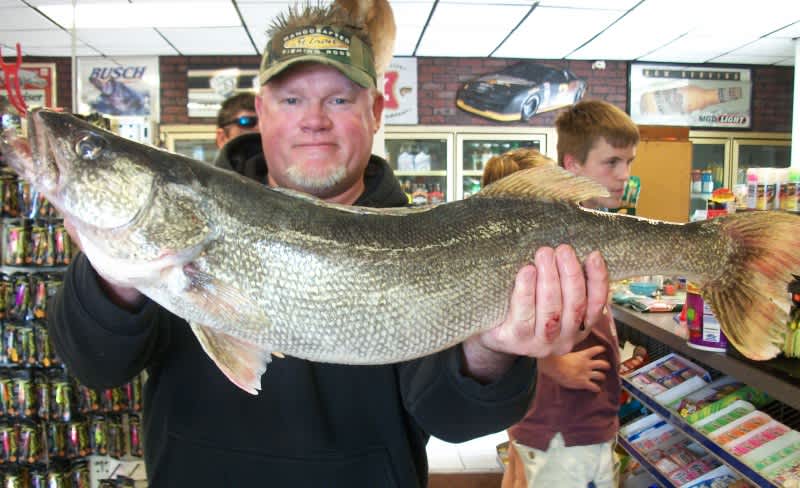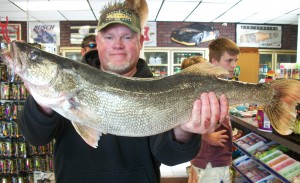Weapon Rig Walleye 101
Justin Clark 06.20.11


Lake Erie has gone through a lot of changes in the past 20 years. It has gone from a lake you could barely see a few inches into the water, to a lake that you can see 25ft down during the winter months and sight fish for walleye during the ice season. With these changes, fisherman have had to learn and adjust to the changing conditions and changing fish behavior.
One of these new approaches has been with what is locally called a “Weapon Rig” on Lake Erie. The weapon rig was made popular by charter boats and their captains that specialized in drift fishing, like the late Captain Steve Droulliard, who fished out of Bolles Harbor. The weapon rig is designed after the Mayfly , commonly called “Fish fly” or Hex for you fly guys, population began to boom on the lake with the cleaner water thanks to the zebra mussels.
The mayfly’s begin to rise from the lake bed during the first part of June every year. At this time the walleye, as well as other species on Lake Erie begin to key in and feed on them as they make their way to the surface for their short adult life to mate and start the next generation of these tasty fish morsels. It used to be said by the older generations that the walleye would quit biting during the hatch because they were too busy feeding on the bugs. The weapon rig blew that theory up, and anglers have been noticing big numbers coming back to the launches during the lake’s hatch.
To combat this period when other methods like trolling spoons and crank baits yield few fish, the weapon rig is used. The rig itself is a simple compact single hook harness, that kinda looks like a Carolina Rig employed by bass anglers. Normally when you think walleye harness you might think two and three hook rigs with large blades in size 5 and 6. What makes the weapon rig different is its blade size, leader length, and method in how you fish it.
The weapon rig consists of a number three sized Colorado or Indiana blade, Northland Tackle offers several solid color patterns, as well as their Baitfish Image holographic blades. Purples, copper and gold finishes are favorites of many anglers. Next use four or five 5mm beads threaded on a 18 inch leader snelled with 15 to 20 pound fluorocarbon line with a number 4 or 6 size octopus hook. Although, my personal favorite is the Walleye Wide Gap from Gamakatsu . An egg sinker is added to provide weight and is threaded onto a small sturgeon loop tied with a bead inside it. The bead within the loop prevents the weight from sliding down the length of leader. The rig is attached to the main line with a number 7 or 8 snap and swivel. The reason for the downsized rig is two fold, short enough for easy casting, but is mainly due to the walleye becoming keyed in on mayfly swimming up to the surface to begin the final phase of their lives”Matching the hatch”.
When fishing the weapon rig , you will want to search for suspended fish. It is common to see fish at multiple depths at one time on your LCD fish finder as the walleyes will be suspended at variable depths in the water column. To get to the desired depths where the fish are feeding, anglers employ the countdown method. For you old timers that remember the hay day of Erie Deeries this method should be familiar to you. A ½ ounce egg sinker should give you a sink rate of about a foot a second. Once you have located fish on your electronics, you will want to setup a drift up-wind of that area to pass over the schools of feeding fish. Depending on the wind and size of your boat, the use of one or two drift socks may be needed to slow down your boat to the desired speed..
 Rod choices can be a personal one for the angler to make to get the best “feel” while detecting bites. St. Croix Rods Pro Staffer Chuck Mason of Ida, Michigan, who calls Lake Erie his home waters, uses different rods to match the type of bite taking place during the mayfly hatch. While fishing the top third of the water column for feeding walleyes, he prefers a medium light power 6 foot, 6 inch Avid spinning rod and 3/8ths ounce egg sinkers When Mason sees that the fish are spread out from the bottom to the surface feeding, he switches over to ¾ oz sinkers used in conjunction with a 7ft medium power Avid casting rod. Now he might be the only angler using the casting rod with the weapon rig approach, but there is a reason for it.“When fish are all over the depth spectrum, my casting rod will give me greater distance on the cast, allowing me to reach out and get to the bottom, but covering all depths over that area on the retrieve.”, explained the 30 year Erie veteran. His last rod of choice is specialized for the bottom bite, when dragging the rig in the mud where the mayflies live. To accomplish this, he deploys a 6 foot, 8 inch rod with medium power and an extra fast action is employed when using ½ oz sinkers.
Rod choices can be a personal one for the angler to make to get the best “feel” while detecting bites. St. Croix Rods Pro Staffer Chuck Mason of Ida, Michigan, who calls Lake Erie his home waters, uses different rods to match the type of bite taking place during the mayfly hatch. While fishing the top third of the water column for feeding walleyes, he prefers a medium light power 6 foot, 6 inch Avid spinning rod and 3/8ths ounce egg sinkers When Mason sees that the fish are spread out from the bottom to the surface feeding, he switches over to ¾ oz sinkers used in conjunction with a 7ft medium power Avid casting rod. Now he might be the only angler using the casting rod with the weapon rig approach, but there is a reason for it.“When fish are all over the depth spectrum, my casting rod will give me greater distance on the cast, allowing me to reach out and get to the bottom, but covering all depths over that area on the retrieve.”, explained the 30 year Erie veteran. His last rod of choice is specialized for the bottom bite, when dragging the rig in the mud where the mayflies live. To accomplish this, he deploys a 6 foot, 8 inch rod with medium power and an extra fast action is employed when using ½ oz sinkers.


